- Recent Updates
- Colpoy's Bay
- Colpoy's Bay Introduction
- Spragge's Hill
- The Kalbfleisch House
- The Kalbfleisch Dock
- The Kalbfleisch Marina
- Whicher's Sawmill
- The Wrecks Near Whicher's Mill
- Frame's Falls and John Wood's Grist Mill
- Albemarle Street
- Hughenden and Whicher's Store
- The Community Hall
- The Forest Home Hotel
- The Colpoy's Bay Schoolhouse
- The Colpoy's Bay Church
- Edgehill Cemetery
- Colpoy's Bay From the Air
- A Glimpse of the Past
- Wiarton
- Berford Street
- Berford St. Part 2
- Berford St. Part 3
- Wiarton Harbour
- Bluewater Beach
- Caframo Ltd. and Wiarton Cement Works
- Wiarton Beet Sugar Factory
- Wiarton's Hotels
- Wiarton's Schools
- Wiarton's Banks
- Grand Trunk Railway Station
- The Wiarton Fish House
- The Wiarton Fish Hatchery
- Wiarton's Berford Theatre
- The Wiarton Woolen Mills
- Wiarton's Furniture Industry
- Wiarton's Hospital
- Wiarton's War Memorial
- Wiarton's Town Hall
- Wiarton's Newspapers
- Wiarton's Grist & Flour Mills
- Wiarton's Sawmill Industry
- Wiarton's Gateway
- Connecting Passages
(Links) - Present-day Map
of Colpoy's Bay - Colpoy's Bay
Lot Map (1870) 
Wiarton Timeline- Present-day Map
of Wiarton - Bibliography
- About the Author
- Site Map
(use if menu doesn't work) - Tell me your impressions!
Wiarton's Hotels
In the late 19th Century travel was still a slow process by today's standards. The average horse and carriage travelled a mere 5 kilometres (just over 3 miles) per hour with the best 4-horse carriage hitting 13 kilometers per hour (about 8 mph). At this speed the trip from Wiarton to Owen Sound (about 40 kilometres) would take three to 6 hours. Today it takes, about half an hour to make this trip.
With travel being so cumbersome, people visiting town would usually stay for a while before moving on. Of course, motels did not arrive until travel by car became popular. Thus, grand old hotels were the only place to stay and most towns had several of them.
As far as I know, no photographs remain of Wiarton's earliest hotels. Records indicate, however, that the first hotel was built in 1867 by BB Miller on the southeast corner of Gould and Division Streets. The Echo newspaper would later describe this hotel as more of a "stopover place or boarding house". Nevertheless, Miller's hotel was the first business established in Wiarton. (Others would soon follow suit, making the corner of Gould and Division the birthplace of comemrcial Wiarton.) After passing through a handful of proprietors, it appears that Miller's hotel had ceased operations by 1879. In any event, the property was put up for sale by Mr. Thomas Bradford in 1883, ending up in the hands of local businessman William Ashcroft in 1890. Mr. Ashcroft converted the former Miller hotel into an apartment building. I have yet to determine the exact date this building was taken down and replaced, but it appears to have survived at least three additional decades.
By 1871 Mr. Joseph Crandon had established Wiarton's second hotel, The British. All published descriptions of Mr. Crandon's hotel describe its location as "quite nearby" Miller's hotel. Based on 1871 census records, I believe the British Hotel stood on lot four of Gould St., just three lots south of Miller's hotel. (Indication is not given as to whether this was on the west or east side of Gould St.) By 1879, Crandon sold what was then called the Dominion Hotel to J. Bradley, who ran the hotel for three more years until it was closed, likely due to competition from newer establishments. The building was demolished in 1897 to make way for cottages.
Marking a shift in the business centre of Wiarton, the village's third hotel was built on Berford St. instead of Gould St. More specifically, a Mr. and Mrs. Mitchell constructed the large two-storey frame hotel on the southeast corner of Berford and Division Streets (one block east of Miller's hotel) likely in 1872. By 1876 Mr. Thomas Bradford was running the new establishment under the name "Victoria Hotel". Figure W8A shows an ad which Mr. Bradford published in the 1876 Bruce County directory.
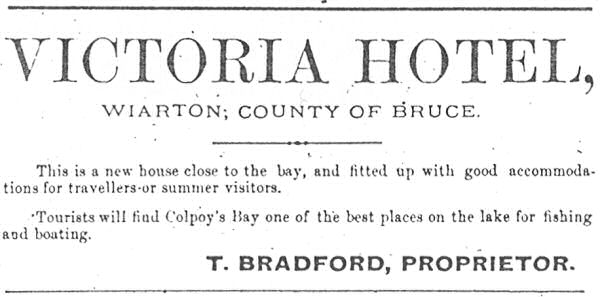
Figure W8A: Advertisment for the Victoria Hotel, later known as the Commercial Hotel (c. 1876).
Soon afterward, however, Mr. Henry R. A. Ely assumed ownership of the hotel, renaming it the Commercial. Locally, even though the Commercial was later run by other proprietors, it was affectionately referred to as the Ely House from then on. Sadly, after nearly 40 years of operation, the Ely House was the unfortunate victim of a fire on April 11, 1910. The ruins of the hotel remained on the site until the fall of 1918 and it took another 8 years until Duncan Sinclair (son of George S. Sinclair, the owner of the Vuclan Foundry, Wiarton's original foundry) erected the present building in 1926. Although it was intended as an automobile showroom, Duncan Sinclair's building was used as a machine shop and hardware store. Today the Wiarton Co-op occupies the building on the former site of the Ely House.
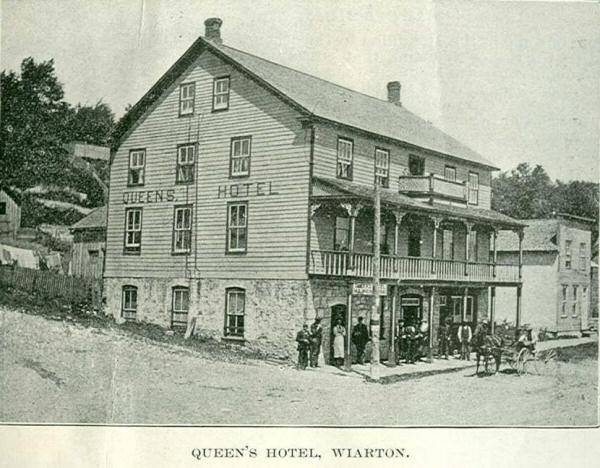
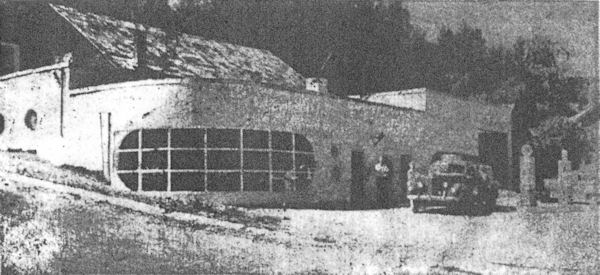
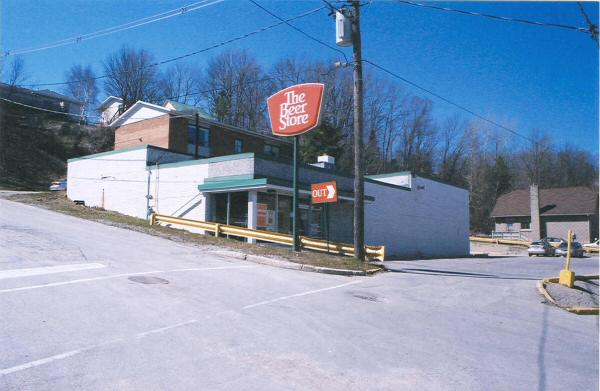

Figure W8B: Queen's Hotel (c. 1899), Bus Terminal (1947), Beer Store (2004 and 2023)
The last of Wiarton's frame hotels, the Rush House also was erected in 1873, kitty-corner to the Ely House (northwest corner of Berford and Division St.). Renamed the International Hotel in June of 1880 by its new owner James Spence, it immediately received a thorough upgrade. Beginning the following year, it was known simply as the Spence House. Around 1887 it was renamed the North Star Hotel, then finally, it was titled the Queen's Hotel in January of 1892 (see Figure W8B). Townspeople still reminisce about to the old Queen's Hotel to this day. A description from 1905 suggests the Queen's was a quality establishment, serving mainly farmers and lumbermen travelling the Bruce Peninsula. Evidence suggests the hotel closed in 1917, although the building survived as a boarding house/apartments until it was demolished in August of 1944. In 1947 a new building was opened on the site (click here to see a westward view of construction on the site, following the removal of the Queen's Hotel). Serving as a bus depot, service garage and lunch counter, the new structure featured, perhaps, the most modern architectual style in the town. As shown in the middle image of Figure W8B, key features included clean, smooth lines and a rounded corner with a large elliptical window complemented elsewhere by smaller circular accent windows. Unfortunately, by the time the building was taken over by a franchise of the Beer Store in 1965 (who had moved a block and a half north of their previous site), the distinguishing features of this Art Deco gem were lost. As shows in the bottom two images of Figure W8B, the building, which still houses the beer store to this day, no longer stands out architecturally. Its distinctive rounded windows have been filled in with plain brick and squared off.
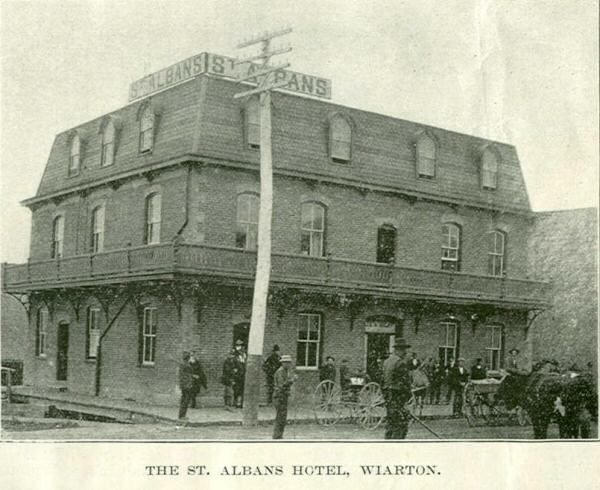
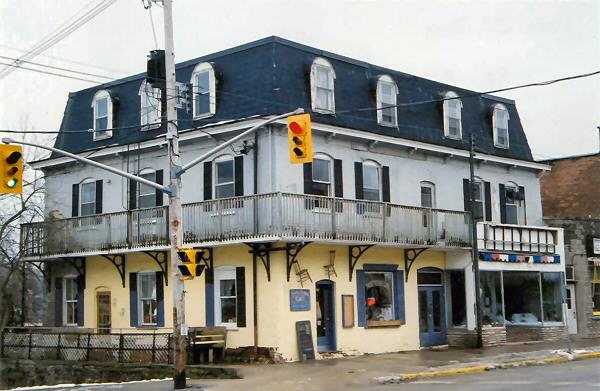
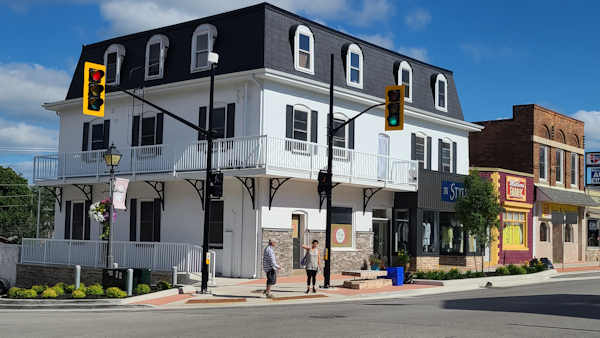
Figure W8C: St. Alban's Hotel (1899, 2003, 2022)
Wiarton's booming sawmill years were heralded by the first of Wiarton's second generation hotels, the formidable St. Albans. Wiarton's finest example of 2nd Empire architecture, construction of the St. Albans began in the fall of 1880 at the corner of Berford and William Streets with its doors opening for business in September 1881 (see Figure W8C above). The first hotel in town built of brick, it appears to have been a well-equipped hotel giving great value for the dollar. Its arrival marked the death knell for the old Dominion Hotel on Gould St. The basement of the St. Albans featured two cellars and a kitchen. The bar, dining room, reading room, waiting room and sample accomodations were contained on the first floor. A sitting room, the parlour and the first eight of thirty bedrooms were up on the second floor. The remaining bedrooms occupied the third floor. Patronage came largely from the farming and commercial trades.
The St. Alban's Hotel closed its doors in 1920 at which time the block was converted to mixed use. The bar area on the first floor was remodelled into a store with the remainder being used as a cafe. The second floor was converted to apartments with the top floor open for lease. By 1960 the former St. Alban's came to be known as the "Nixon Block".
The structure stands to this day, although some changes are noticeable. Today some of the designed brickwork (corner quoins) has been painted over. The rounded windows have been replaced with square ones and bracketed by false shutters. Also, a store has been incorporated on the ground floor. Nonetheless, this building retains its original 1888 balcony brackets which give a hint toward its founding purpose. The 2022 image shows the building looking sharp with a fresh coat of pain nad new balcony railings. Notably, the original corbels (brackets) under the mansard roofline have been removed.
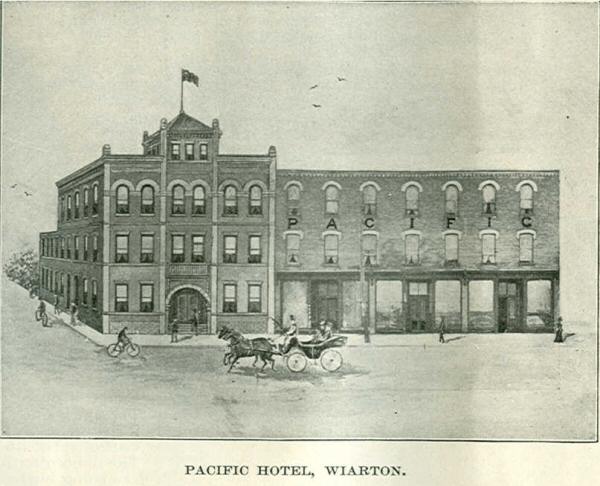
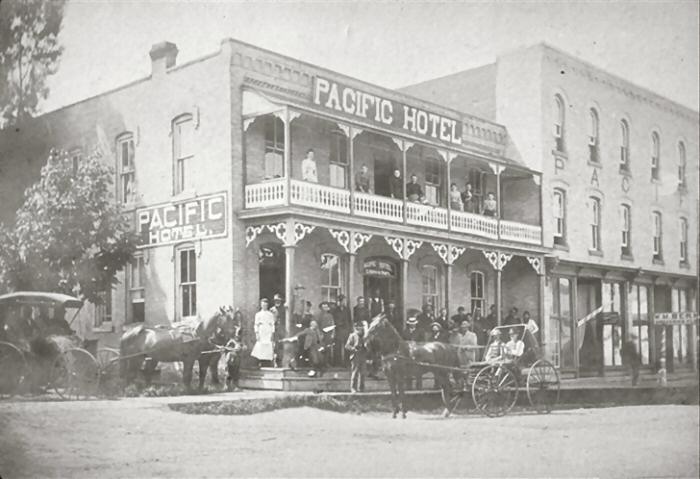
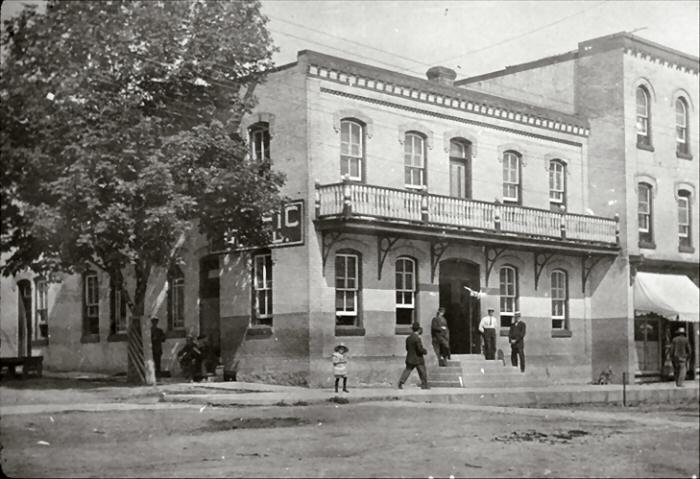
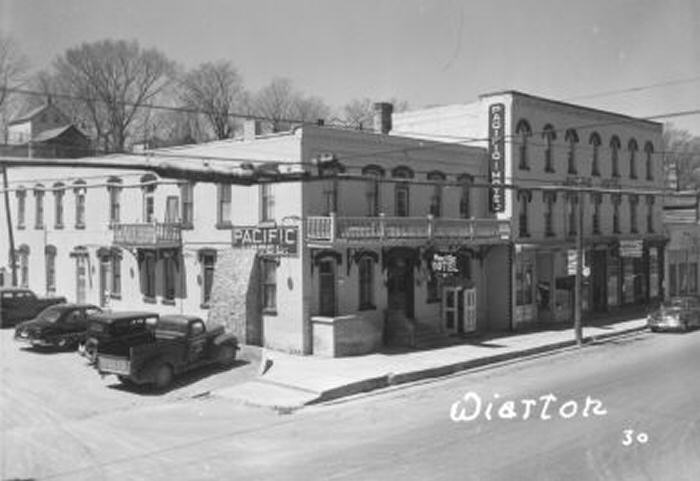
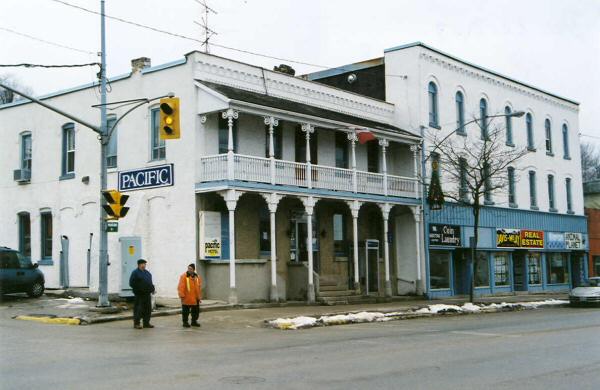
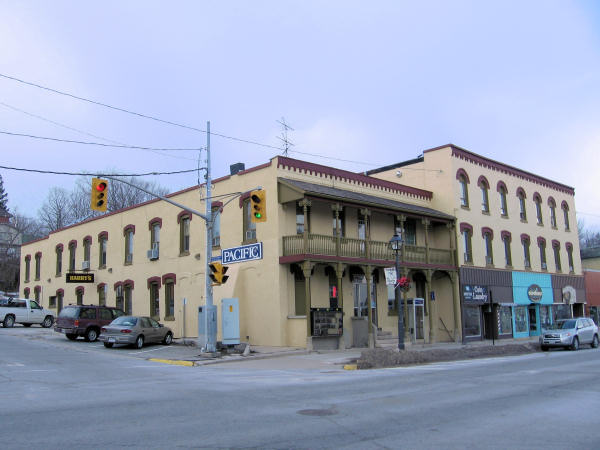

Figure W8D: Pacific Hotel (engraving from about 1889, photos from late 1890s, about 1915, 1950, 2003, 2008, 2023)
One year after the St. Albans opened for business, excavation for an even larger hotel was begun at the corner of Berford and William Streets. This would be the venerable Pacific Hotel which hosted its opening supper in January of 1883 (see Figure W8D above). It served the higher-end market in Wiarton, featuring a bar, office, reading room, dining room, kitchen, pantry, washroom and sitting room on the first floor. The second floor contained two parlours with the remaining space taken by bedrooms. The front facade of the Pacific was dominated by a finely crafted balcony and a 24 foot sign bearing its name.
Six years later, in 1889, the Pacific received a large 3-storey addition to the north. Interestingly, the top image of Figure W8D dates from this period, and may show a proposed remodelling and expansion of the original 2-storey portion of the hotel (on the left hand side). However, the original 2-storey block, with its more restrained architectural style, remained while the new 3-storey block to the north garnered praise in the town for giving a finsihed look to that part of Berford Street (see second image from top in Figure W8D).
The bottom four images of Figure W8D show how little the exterior of the Pacific has changed over the years. Today it holds the unique distinction of being the only hotel that remains in operation in Wiarton (there are now several motels and inns around the town). It now looks much the same as it did over 120 years ago (having outlived a "coral rose" paint job in 1959!). Notably, the hotel's balcony had been completely removed in the 1960s, but has since been rebuilt, a return to its original style from the late 1890s.
In 2006, the facade of the Pacific Hotel was altered somewhat when a new large window was installed on the second floor in place of the two northernmost original windows. The second floor door was also replaced at the same time. (Click here to see a photo of the changes before the old window space had been covered up.) Unfortunately, this renovation damaged the symmetry of the original 1883 facade. On a more positive note, the hotel received an attractive new paint scheme in the summer/fall of 2008. Around 2023, this was changed to a dark green colour with black accents (see bottom two images in Figure W8D). Some work was also done to the front of the building. The first floor pillars were simplified in style with the removal of the decorative capitals on top (although the capitals remain on the second floor pillars). Street-level access to the hotel was also moved to the southeast corner with a new set of stairs leading up to the front door and a smooth cinder-block retaining wall along Berford Street. Note the disappearance of the long-standing pay telephone visible in the 1950, 2003 and 2008 images.
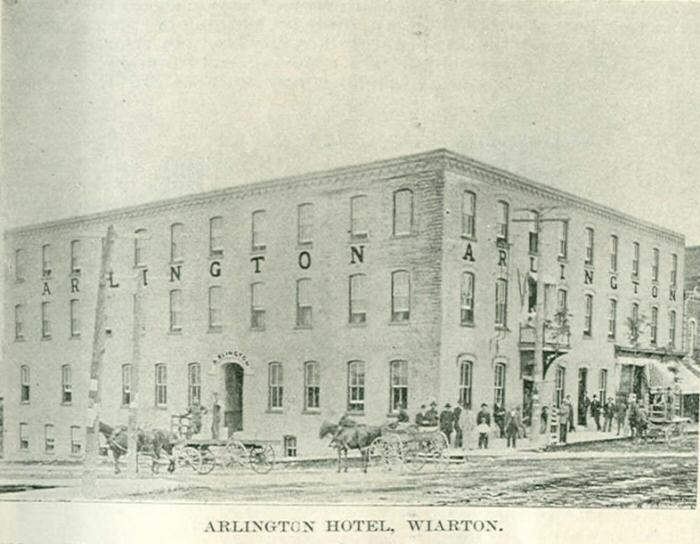
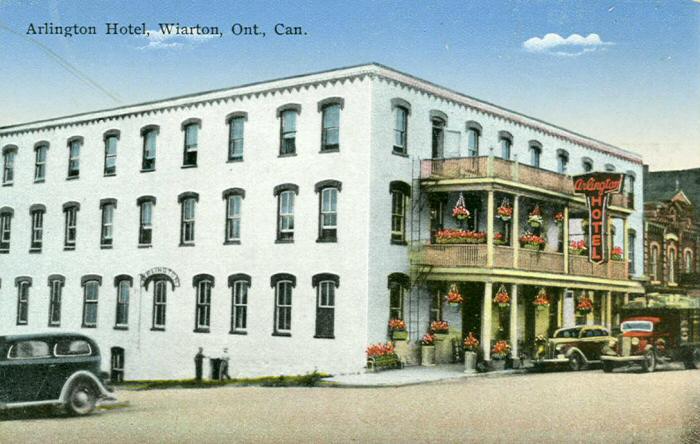
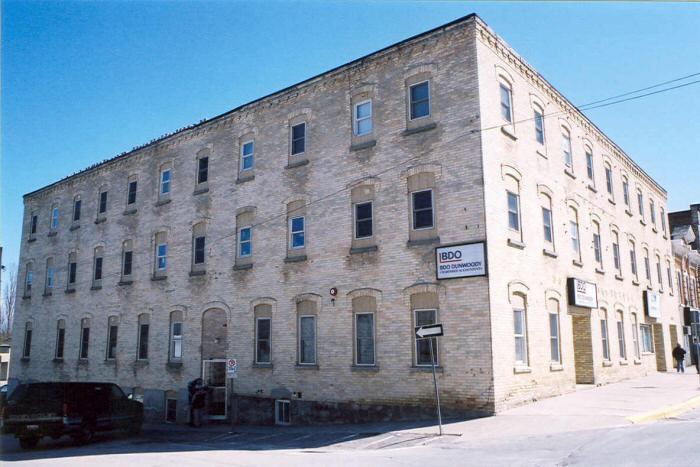

Figure W8E: Arlington Hotel (1899, c. 1940, 2004, 2023)
FIgure W8E shows the Arlington Hotel. Despite the existence of 4 other hotels, Wiarton still suffered from a shortage of lodging when plans to build the Arlington were announced in late July of 1887. It must have been a grand spectacle to see all of the hotel's windows lit on its opening night of July 11, 1888. The town's brass band performed out in front of the hotel and were later treated to an Oyster supper in the hotel's dining room. The Arlington was Wiarton's final grand hotel and as such, it was the largest, most modern and was classed among the finest in all of Canada. One could view sample rooms on the ground floor, along with the office, bar and dining room. Parlours were located on the second floor as well as single room accomodations and larger suites that included an attached bedroom.
In comparing the images in Figure W8E, it is interesting that the building originally featured only a small balcony on the second floor. In the late 1890s, this was expanded along the facade of both the second and third storeys (partly to serve as a fire escape). Today, only the markings on the brick are visible where the balcony was once anchored. The balcony came down in April of 1961. Small rectangular windows have replaced the original rounded windows, giving the facade an awkward appearance. The white and black paint has also been removed, to expose the original yellow brick.
The Arlington Hotel appears to have run continuously until mid-1983 at which time it closed its doors under a burden of debt and unpaid taxes. It returned, however, for a final stretch from 1984 until the middle of 1989 (featuring exotic dancers). At this time the hotel closed once and for all and the structure was renovated to serve as office space under the name "Arlington Building".
At one time Wiarton boasted at five large hotels, servicing visitors and residents from all walks of life. It is somewhat ironic that even though Wiarton is now primarily a tourist economy, only one of these old hotels is still in operation. Others have left behind their buildings as a testiment to the town's early days. They serve as excellent examples of the architectural styles of the day.

